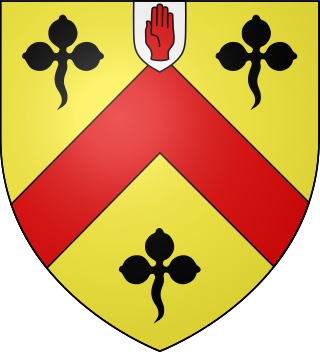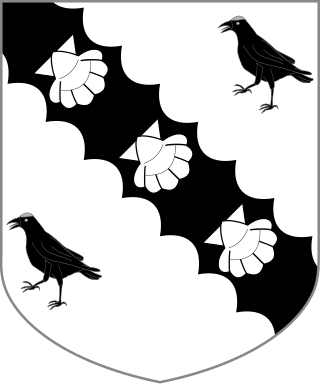
The Eliott Baronetcy, of Stobs in the County of Roxburgh, is a title in the Baronetage of Nova Scotia. It was created on 3 December 1666 for Gilbert Eliott. The second baronet was a member of the pre-union Parliament of Scotland. The third Baronet sat as Member of Parliament for Roxburghshire. The Eliott Baronets share a common early Elliot ancestry with the nearby Earls of Minto (Elliot). It is thought that the surname spelling differences were contrived to differentiate the branches.
There have been two baronetcies created for persons with the surname Aykroyd, both in the Baronetage of the United Kingdom for members of the same family.

The Bunbury Baronetcy, of Bunbury, Oxon and Stanney Hall in the County of Chester, is a title in the Baronetage of England. It was created on 29 June 1681 for Thomas Bunbury, Sheriff of Cheshire from 1673 to 1674 and the member of an ancient Cheshire family. His grandson, Henry, the third Baronet, and great-grandson, the fourth Baronet, both sat as Members of Parliament for Chester. The latter died unmarried at an early age and was succeeded by his younger brother, the fifth Baronet. He was a clergyman. On his death in 1764 the title passed to his eldest son, the sixth Baronet. He represented Suffolk in the House of Commons for over forty years but is best remembered for his marriage to Lady Sarah Lennox. He died childless in 1821 and was succeeded by his nephew, the seventh Baronet. He was the son of Henry Bunbury, younger son of the fifth Baronet. The seventh Baronet was a distinguished soldier and politician. His eldest son, the eighth Baronet, was High Sheriff of Suffolk in 1868, and Fellow of the Royal Society. He died childless in 1886 and was succeeded by his younger brother, the ninth Baronet. He was Liberal Member of Parliament for Bury St Edmunds. He died unmarried in 1895 and was succeeded by his nephew, the tenth Baronet. He was the son of Colonel Henry William St Pierre Bunbury, third son of the seventh Baronet. He served as High Sheriff of Suffolk in 1908 and was a Deputy Lieutenant of the county. On his death in 1930 the title passed to his son, the eleventh Baronet. He was High Sheriff of Suffolk in 1936 and was a Deputy Lieutenant of the county. His son, the twelfth Baronet, was High Sheriff of Suffolk in 1972. As of 2014 the title was held by the latter's second but eldest surviving son, the thirteenth Baronet, who succeeded in 1985.

The Selby-Bigge Baronetcy, of King's Sutton in the County of Northampton, was a title in the Baronetage of the United Kingdom. It was created on 14 February 1919 for the civil servant and author Sir Amherst Selby-Bigge. He was Permanent Secretary to the Board of Education from 1911 to 1925. The title became extinct on the death of the second Baronet in 1973.

The Baynes Baronetcy, of Harefield Place in the County of Middlesex, is a title in the Baronetage of the United Kingdom. It was created on 29 June 1801 for Christopher Baynes. He was Major-Commandant of the Uxbridge Gentlemen and Yeomanry Cavalry, which he helped to raise. The title descended from father to son until the death of his great-great-grandson, the fifth Baronet, in 1971. The late Baronet died unmarried and was succeeded by his first cousin, the sixth Baronet. He was the son of Reverend Malcolm Charles Baynes, fourth son of the third Baronet. As of 2023 the title is held by his grandson, the eighth Baronet, who succeeded his father in 2005.
The Brownrigg Baronetcy is a title in the Baronetage of the United Kingdom. It was created on 9 March 1816 for General Robert Brownrigg. He was Governor of Ceylon from 1813 to 1820. He was succeeded by his grandson, the second Baronet. On his death the title passed to his younger brother, the third Baronet. His eldest surviving son, the fourth Baronet, was a Rear-Admiral in the Royal Navy. As of 2024 the title is dormant.

The Macgregor Baronetcy, of Savile Row in the County of Middlesex, is a title in the Baronetage of the United Kingdom. It was created on 17 March 1828 for Patrick Macgregor, Serjeant-Surgeon to King George IV. Charles Reginald Macgregor (1847–1902), second son of the third Baronet, was a Brigadier-General in the Army.

The Oakeley Baronetcy, of Shrewsbury, is a title in the Baronetage of Great Britain. It was created on 5 June 1790 for the Indian administrator Charles Oakeley. He served as Governor of Madras from 1790 to 1794. Frederick Oakeley was the second son of the first Baronet.
The Goold Baronetcy, of Old Court in the County of Cork, is a title in the Baronetage of the United Kingdom. It was created on 8 August 1801 for Francis Goold, with remainder to the heirs male of his father Henry Michael Goold, who gave valuable service to the government of King George III. The Goold family descends from William Gould, who served as Mayor of Cork during the reign of King Henry VII. His descendant George Gould changed the spelling of the surname to Goold. He was the father of Henry Michael Goold and the grandfather of the first Baronet.

The Leeds Baronetcy, of Croxton Park in the County of Cambridge, is a title in the Baronetage of the United Kingdom. It was created on 31 December 1812 for George Leeds. He was an equerry to Prince Augustus Frederick, Duke of Sussex. The Croxton Park estate in Cambridgeshire had been in the Leeds family since circa 1568. As of 2011 the presumed ninth and present Baronet, a resident of Canada, has not successfully proven his succession and is not on the Official Roll of the Baronetage.

The Hamilton baronetcy of Preston, Haddingtonshire was created in the Baronetage of Nova Scotia on 5 November 1673, for William Hamilton, eldest son of Sir Thomas Hamilton, of Preston and Fingalton, by his second wife, Anne Hamilton, of Preston. He married in 1670 Rachel Nicolson of Cockburnpath, but left no male issue, sold his estates, and died c.1690, having left Scotland for the Netherlands. The title passed to his brother Robert, 2nd Baronet. On his death, the title was regarded as dormant, until legal cases in the 19th century saw it revived, and imputed to successors. The name was changed to Stirling-Hamilton in 1889.

The Fletcher, later Boughey Baronetcy, of Newcastle-under-Lyme and of Betley both in the County of Stafford, is a title in the Baronetage of Great Britain. It was created on 24 August 1798 for Thomas Fletcher, of Betley Court, Staffordshire, High Sheriff of Staffordshire in 1783 and 1789 and Deputy Lieutenant of the county. He was the husband of Elizabeth Fenton, granddaughter of George Boughey, of Audley, Staffordshire whose will provided for his great-grandson to inherit the Audley estate.

The Lynch Baronetcy of Galway – which later became Lynch-Blosse Baronetcy – is a title in the Baronetage of Ireland. It was created on 8 June 1622 for Henry Lynch, a member of an Anglo-Norman family and one of the merchant Tribes of Galway. Both he and the second Baronet represented County Galway in the Irish House of Commons. The third Baronet was a Baron of the Court of Exchequer (Ireland). Forced to flee to France after the Glorious Revolution, his eldest son succeeded to the title and estates. The family seat was Athavallie House, Castlebar, County Mayo. The sixth Baronet assumed the additional surname of Blosse, having married Elizabeth, daughter and heir of Francis Barker, heir of Tobias Blosse. The seventh Baronet also served in the Irish House of Commons representing Tuam.
There have been two baronetcies created for persons with the surname Gibbons, one in the Baronetage of Great Britain and one in the Baronetage of the United Kingdom. One creation is extant as of 2012.

The Wardlaw Baronetcy, of Pitreavie in the County of Fife, is a title in the Baronetage of Nova Scotia. It was created on 5 March 1631 for Henry Wardlaw, Chamberlain to Anne of Denmark, consort of James VI, with remainder to heirs male whatsoever. He had acquired Pitreavie in 1606 and this was erected into a barony in 1627. As of 13 October 2008 the presumed twenty-first and the twenty-second Baronets have not successfully proven succession and are therefore not on the Official Roll of the Baronetage, with the baronetcy considered dormant since 1983. The poet Elizabeth, Lady Wardlaw was the wife of the fourth Baronet.

The Abdy Baronetcy, of Albyns, in the County of Essex, was created in the Baronetage of the United Kingdom on 22 December 1849 for Thomas Neville Abdy who sat for Lyme Regis in the British House of Commons. It was a second creation for the seat: see Abdy baronets of Albyns (1660).

The Bruce, later Bruce-Clifton Baronetcy, of Downhill in the County of Londonderry, was created in the Baronetage of the United Kingdom on 29 June 1804 for Reverend Henry Bruce. He was a descendant of Patrick Bruce, younger brother of the first Baronet of the 1628 creation, and the brother of Sir Stewart Bruce, 1st Baronet, of Dublin. The third Baronet was a Conservative politician. The fourth Baronet was High Sheriff of County Londonderry in 1903. The seventh Baronet assumed the additional surname of Clifton in 1997.

The Russell baronetcy, of Swallowfield in the County of Berkshire, was created in the Baronetage of the United Kingdom on 10 December 1812 for Henry Russell. He was Chief Justice of Bengal and was admitted to the Privy Council in 1816. The 3rd Baronet represented Berkshire and Westminster in the House of Commons as a Conservative and was also awarded the Victoria Cross. The 4th Baronet sat as a Conservative Member of Parliament for East Berkshire. The 6th Baronet was a noted mineralogist.

The Rowley baronetcy, of Hill House in the County of Berkshire, was created in the Baronetage of the United Kingdom on 21 March 1836 for the naval commander Admiral Charles Rowley. He was the fourth son of the 1st Baronet of the 1786 creation.

The Macdonald baronetcy, later Bosville Macdonald Baronetcy, of Sleat in the Isle of Skye, County of Inverness, was created in the Baronetage of Nova Scotia on 14 July 1625 for Donald Macdonald. The 9th baronet was created Baron Macdonald in 1776.

















